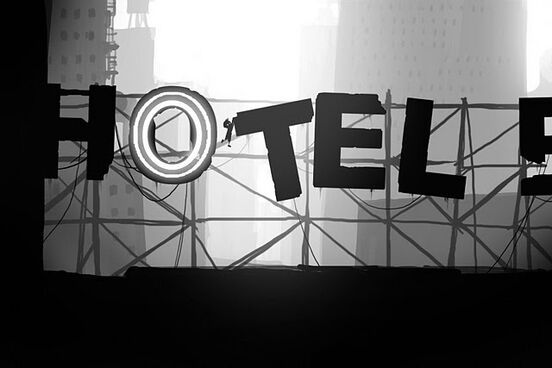Have you played Limbo? Oh, man, you've got to play Limbo.

Don't watch any trailers. Don't YouTube any walkthrough videos. Just download it and play it. Turn the volume up. Keep the screen brightness relatively dark. And just go in cold. Experience it. I don't think you'll regret it.
Limbo, of course, is pretty much old news by now. It had its moment in the spotlight, but it's basically one of those relatively short games that you go through once and that's pretty much it.
Or is it?
I found myself going back to the puzzle-platformer this past weekend. It had been about a year since I'd played through. I had thought at the time that the puzzles were clever. They were logical, but not too obvious at first glance. Challenge increased with progress. And while the game relied on plenty of trial and error, the learning curve proved more intuitive than skull-bashing. Limbo also avoided repetition. Each successive puzzle, even if it contained elements from previous puzzles, threw clever new tricks into the mix.
Aesthetically, Limbo also was a beautiful game that offered no narrative explanations and instead welcomed any and all interpretations. And when it was over it was over. Fin.
So why return?

It comes back to those stupid Xbox achievement points. They're just points, I know. They don't do anything. And yet playing a game doesn't necessarily do anything either. The games are what we make of them. And so the best achievement points, as I see it, are the ones that steer the player toward approaching the game in a new kind of way. It could be like writing a new, completely optional set of rules to a pre-established game.
On the one hand, these optional points can be an irritating thorn in the side of players who happen to be obsessive “completionists,” sort of like those insane folks addicted to maintaining as many Guinness world records as possible, but on a smaller scale. On the other hand, it bears repeating these points are optional. Pursue the most challenging and time-consuming achievements at your own risk.
In Limbo there is one major achievement that nets 100 points for simply completing the game. And while neither the name nor description of the achievement (“Where Credit is due — Persistence has its own reward”) makes this explicitly clear, that’s what it is. Anyone who makes it through to the end—whether they look up the puzzle solutions online or rely on their own brainpower all the way through—will earn this achievement.
Then there is a series of ten rather cryptic achievements, two offering 5 points each and the other eight each worth 10—making for a combined total of 90 points. During my first time through the game I had assumed these referred to progress-based mileposts that would automatically unlock for solving the main puzzles. That’s not the case, but I'll talk about these more in a second.
Finally, there is one dastardly achievement for Limbo that tasks the player with completing the game in one sitting and dying no more than five times. Considering the swiftness and frequency of death in a typical player’s first run through the game, that's a pretty tall order. And frankly, for only 10 achievement points, not too many people are going to try for it. That’s okay.
So when I loaded the game over the weekend I did so in the interest of unlocking those ten cryptic achievements. Without actively trying, I actually had managed to nab one during my first run. I had been attempting to figure out a timing-based puzzle close to the end of the game (I didn’t know at the time it was close to the end) when I happened to go exploring in a particular direction at a particular moment, suddenly finding my player avatar in a particular spot of the two-dimensional playing area that I hadn’t realized was accessible a moment earlier. I thought I had found the location of the key to advancing the puzzle. Instead I found a strange egg-like item (a Limbo Easter egg?) that unlocked an achievement. It had nothing to do with solving the puzzle at hand.
It then became clear the remaining nine cryptic achievements each referred to more of these hidden items. The names and descriptions of the achievements were clues:
- Wrong Way — That’s not right (5 points)
- Altitude is Attitude — Exploration off the ground (5 points)
- It’s Stuck — Prepare a dry landing (10 points)
- Urban Exploration — Involves heavy lifting (10 points)
- Alone in the Dark — Beneath the arthropod (10 points)
- Climbing the Cog — Don’t pull the lever just because you can (10 points)
- Backtracking — Ride the Crates (10 points)
- Guided by Sparks — The crate is key (10 points)
- Under Ground — Vertical passageway (10 points)
- Going Up — Don’t let gravity keep you down (10 points)
By re-reading these clues, I had a pretty good idea where some of the other hidden items might be located. So that’s what I focused on for my most recent play through, finding those remaining items. Well, I found them, and I had a good time doing it.
In a sense, I would argue these Limbo achievements encourage three basic play-through modes. The first and most important play through is all about completing the basic game. It’s about figuring out how to do it and doing it. This may or may not involve finding some of the hidden eggs, but the second play-through mode is to locate either all of or the remainder of the collectibles. It’s about the player referencing their memory and knowledge from their first play through and discovering the rather elegantly hidden game within the game—little puzzles contained inside the big puzzle. The third play through is to master the game by completing with minimal deaths—no more than five for the achievement. I can’t speak too much about the latter because I haven’t made any attempts to play through according to that set of rules.
So … what’s my point in all of this?
The point is this. It’s the simple things that matter. I encourage everyone to experience Limbo’s first play-through mode. That’s a given. I was surprisingly impressed, however, with the second mode as well. Finding hidden items simply for the sake of finding hidden items can actually be quite satisfying—when done smartly!
It would be quite possible to find each of the hidden Limbo eggs without any hints. It’s also possible to go through and not stumble upon any of them at all (as I almost did). Sometimes all it takes is a little bit of exploration, or paying close attention when noticing an area of the traversable screen that seems disconnected from the more visible path of forward progress. In a game such as Limbo, where every interactive element is in its place for a specific reason, that inexplicable object or open area would be a red flag.
But anyone who has ever tried to locate hidden video game items without cheating can probably tell you what an exhausting and maddening experience it can be. Sure, the completion-obsessed player may find some or even most of the items in a given game, but more likely than not there will always be those elusive needles in the proverbial haystack. Finding needles is great, but looking for them with no hot/cold feedback or helpful navigation often frustrates. In lieu of spending more potentially wasted time and energy poking through a level or game world, the player will eventually resign to seeking the answer online. From a game-playing perspective, this defeats the entire purpose of hiding whatever item is being sought after in the first place.
For this reason, Limbo’s clues function brilliantly. For one—and I don’t mean to spoil anything by revealing this—they are listed chronologically in relation to the linear progress of the game. The first listed achievement ("Wrong Way") is obtained before the second ("Altitude is Attitude"), the second before the third and so on. Second, each achievement name and description work together to point out types of landmarks or indicators. The “It’s Stuck” achievement description implies water. “Climbing the Cog” implies both a cog and a lever. They’re great hints, and in this case developer Playdead just happened to use the Xbox achievements system for presenting them. Instead of looking for a needle in a haystack, the activity becomes a scavenger hunt. It’s still about discovery and exploration, but it’s a type of exploration—it's a type of game!—that respects your time and energy.
In my next post I'll continue this train of thought further and discuss how Limbo's treatment of hidden collectibles informs and compares to similar features in other game titles. Stay tuned!

(Images for this post were borrowed from http://tig.wikia.com/wiki/Limbo and http://strategywiki.org/wiki/LIMBO.)
Oh man, this post is all about the reward cycle. I will come back & talk about that later, because it excites me. It's a big thing in tabletop design circles (and I imagine VG design circles, but I don't run in those).
ReplyDeleteThis is the key:
"They're just points, I know. They don't do anything. And yet playing a game doesn't necessarily do anything either. The games are what we make of them. And so the best achievement points, as I see it, are the ones that steer the player toward approaching the game in a new kind of way. It could be like writing a new, completely optional set of rules to a pre-established game."
I thought that bit might resonate with you, Hans.
Delete